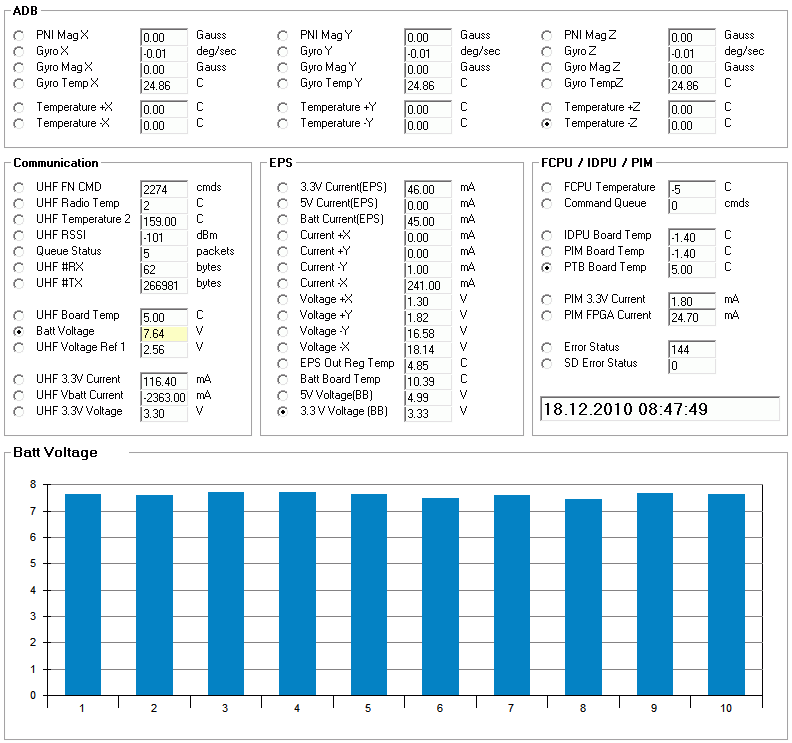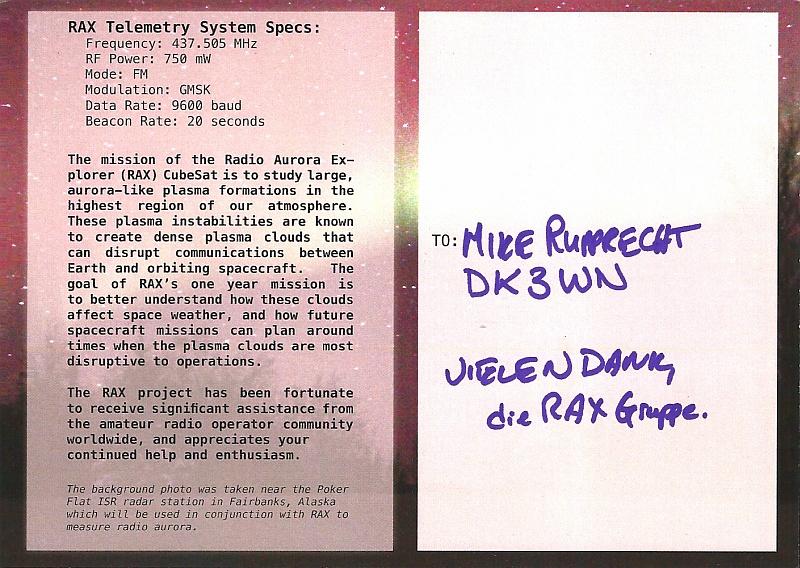Radio Aurora Explorer

The satellite is a space weather science spacecraft carrying a 9600 baud UHF transceiver that will transmit telemetry in the amateur satellite bands. The satellite also carries a radar receiver on board capable of 1 MHz I/Q sampling of select bandwidths between 400-500 MHz, including the amateur satellite bands. The primary objective of the mission is to use the onboard radar receiver in conjunction with a powerful radar station in Alaska to study the formation of a plasma anomaly known for causing the scintillation of radio signals in the UHF and higher bands. This scintillation effect is known to inhibit our space radar tracking capabilities and ground-space communications. Studying this anomaly in this bi-static radar configuration (ground based transmitter, space-base receiver) will provide scientists with a better understanding of these anomalies that has not been achievable with ground radars alone.
Launched as part of the STP-S26 mission on Nov 20th, 01:24 UTC from Kodiak, Alaska on board a Minotaur IV rocket. All satellites are placed into a 650 km altitude, 72 degree inclination circular orbit.
NASA-Catalog: 37223
| Beacon437.505 MHz 9k6 GMSK, FM (750mW) | Telemetriebake RAX-1 9k6 FSK |
Call
RAX-1
Orbital Parameter
Name RAX NORAD 37223 Inklination (Grad) 71.973 RAAN 77.542 Excentrizität 0.0022784 ARGP 263.013 Umläufe pro Tag 14.77198753 Periode 1h 37m 28s (97.47 Min) Semi-major axis 7016 km Perigäum x Apogäum 622 x 654 km Mean Anomaly 96.842
Status
active
Dec 20, 2010: Due to several issues (thermal and cell functionality) RAX solar panels are not producing enough power for nominal operations. The attitude dynamics are also complicating the issue. Long-term health is TBD. Short term, we have put the satellite into ultra low power mode, and we are charging the batteries again. Yesterday we were able to raise the batteries back up to 7.5 V. RAX is back in ULP mode and we will check again tonight. The plan is to use ULP until we get the batteries back up to full charge. Periodic beaconing will be again once we restore the satellite to proper battery health. Time frame for that is unknown.
Telemetrie
Original Beacon Decoder software here.
2010-11-20 04:27:27.080 UTC: [254 Bytes KISS Frame (without CRC)]
ctrl: 3 PID: F0 {UI} 235 Payload Bytes
from CQ to RAX-1:
1 > AB CD 00 00 03 00 03 EB 00 6B 67 6D B0 6D 38 9D 11 6C 7C 01
21 > 00 00 00 00 00 00 00 5F 04 8F 00 62 09 11 00 00 00 4C 00 B9
41 > 00 2C 00 00 00 00 00 1B 00 3D 00 B8 00 6D 03 6B 07 00 00 FF
61 > FF 06 00 00 00 F8 00 6B 07 D8 06 00 00 00 00 16 00 17 03 15
81 > 00 36 01 00 00 DE C2 05 00 00 00 00 00 99 6A 01 00 00 00 7E
101 > FF 1F 01 4B 00 E8 FB 7C 01 C1 01 38 00 00 00 00 00 FE FF 02
121 > 00 FF FF D4 FC 07 01 B6 FF F4 08 84 0A 28 00 18 06 DC 0A 90
141 > 09 B8 03 20 06 6C 09 60 0A 28 00 24 06 B4 0A D0 09 BC 0A FC
161 > 05 28 00 28 00 28 00 50 06 00 05 C4 09 34 00 FC 05 83 38 FF
181 > FF FF 0E 0E D3 D0 5B 5B 5A 5F 5F 5E 5E 9C CF 3F 00 00 9F 20
201 > FF 41 67 FF 9F 5B CF C8 C7 41 9F 00 00 00 3E A0 0E 00 00 FF
221 > FF FF D2 07 02 FF FF FF FF 05 2B 74 DD DF EE

RAX-1 sendet aller 20s einen 9k6 Datenburst (RAW DATA). Der TNC muss sich daher im KISS Mode befinden. Zur Dekodierung dieser Daten wird ein Standard-KISS File benötigt. Es werden ausgewählte Telemetriekanäle angezeigt und graphisch dargestellt. Zusätzlich wird ein CSV File mit allen Telemetriewerten wird erzeugt. Achtung! Nicht alle Telemetriekanäle sind valide (unbenutzt oder uncalibriert).Download Version 1.0 [18.12.2010]

Telemetriekanäle

Homepage und weitere Informationen
http://rax.engin.umich.edu/
AMSAT-DL Symposium 2011 Vortrag
QSL-Karte


tagesaktuelle Telemetriedaten …

Launch
